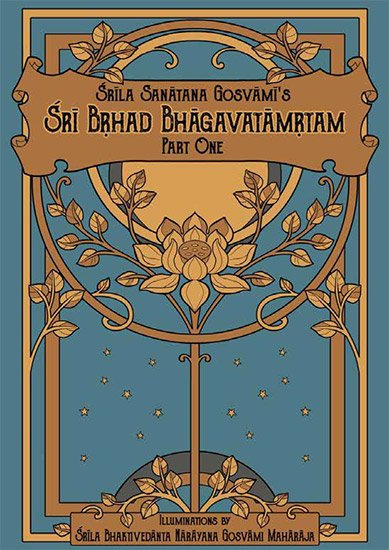Brihad Bhagavatamrita (commentary)
by Śrī Śrīmad Bhaktivedānta Nārāyana Gosvāmī Mahārāja | 2005 | 440,179 words | ISBN-13: 9781935428329
The Brihad-bhagavatamrita Verse 2.4.254, English translation, including commentary (Dig-darshini-tika): an important Vaishnava text dealing with the importance of devotional service. The Brihad-bhagavatamrita, although an indepent Sanskrit work, covers the essential teachings of the Shrimad Bhagavatam (Bhagavata-purana). This is verse 2.4.254 contained in Chapter 4—Vaikuntha (the spiritual world)—of Part two (prathama-khanda).
Verse 2.4.254
Sanskrit text, Unicode transliteration, Word-for-word and English translation of verse 2.4.254:
{DEV}
sugrīvāṅgada-jambavat-prabhṛtibhis tatropaviṣṭaṃ sukhaṃ
śrīmantaṃ madhurair naraiś ca bharataṃ śatrughna-yuktaṃ puraḥ |
dṛṣṭvāhaṃ raghunātham eva nitarāṃ matvā stuvaṃs tat-stavaiḥ
karṇau tena pidhāya dāsya-parayā vācā niṣiddho muhuḥ || 254 ||sugrīva–Sugrīva; aṅgada–Aṅgada; jāmbavat–Jāmbavān; prabhṛtibhiḥ–and the others; tatra–there; upaviṣṭam–seated; sukham–comfortably; śrīmantam–splendid; madhuraiḥ–charming; naraiḥ–with men; ca–also; bharatam–Bharata; śatrughna–Śatrughna; yuktam–joined; puraḥ–before; dṛṣṭvā–seeing; aham–I; raghunātham–Śrī Rāmacandra; eva–indeed; nitarām–completely; matvā–thinking; stuvan–praising; tat-stavaiḥ–with prayers to Him (Śrī Rāmacandra); karṇau–ears; tena–by Him; pidhāya–blocking; dāsya–in service; parayā–absorbed; vācā–with words; niṣiddhaḥ–prohibited; muhuḥ–repeatedly.
There I saw Śrī Bharata and Śrī Śatrughna happily seated, surrounded by personal associates such as Sugrīva, Aṅgada, Jāmbavān, and the most beautiful human beings. I thought that Bharata was Śrī Raghunāthajī, and thus I began to offer prayers of glorification suitable for Śrī Raghunāthajī. Śrī Bharata blocked His ears and said, “I am His servant, I am His servant,” and thus he repeatedly stopped me from reciting the prayers.
Commentary: Dig-darśinī-ṭīkā with Bhāvānuvāda
(By Śrīla Sanātana Gosvāmī himself including a deep purport of that commentary)
Śrī Gopa-kumāra says, “When I saw Śrī Bharata, who was happily seated in that area, I mistook Him for Śrī Rāmacandra and began to praise Him with prayers befitting Śrī Rāmacandra, ‘Jaya! Victory unto you, O emperor of exalted kings! Jaya Śrī Rāghavendra! Jaya O beloved of Śrī Jānakī!’ Śrī Bharata put his fingers in both His ears, forbidding me to praise Him, and repeatedly insisted, ‘I am His servant, I am His servant!’ I mistook Śrī Bharata for Śrī Raghunātha because He was surrounded by Lord Rāma’s personal associates–Sugrīva, Aṅgada, and other beautiful monkeys, as well as the human residents of Ayodhyā.”
Another reason for Gopa-kumāra’s mistake is that Śrī Bharata was comfortably ensconced on a grand throne within the royal palace grounds, sitting gracefully like an emperor. Gopa-kumāra says that Śrī Bharata was śrīmanta (handsome)–meaning that in form, dress, and beauty, He closely resembled Śrī Rāmacandrajī–and so He was very beautiful.
Alternatively, it can be said that Śrī Bharatajī, who is the plenary portion of Bhagavān, was seated with His wife, the plenary portion of Śrī Lakṣmījī. Therefore, because Śrī Bharata’s wife looked similar to Śrī Sītā-devī, and Śrī Śatrughna looked similar to Śrī Lakṣmaṇa, it appeared that Śrī Bharata was Śrī Rāmacandrajī.
